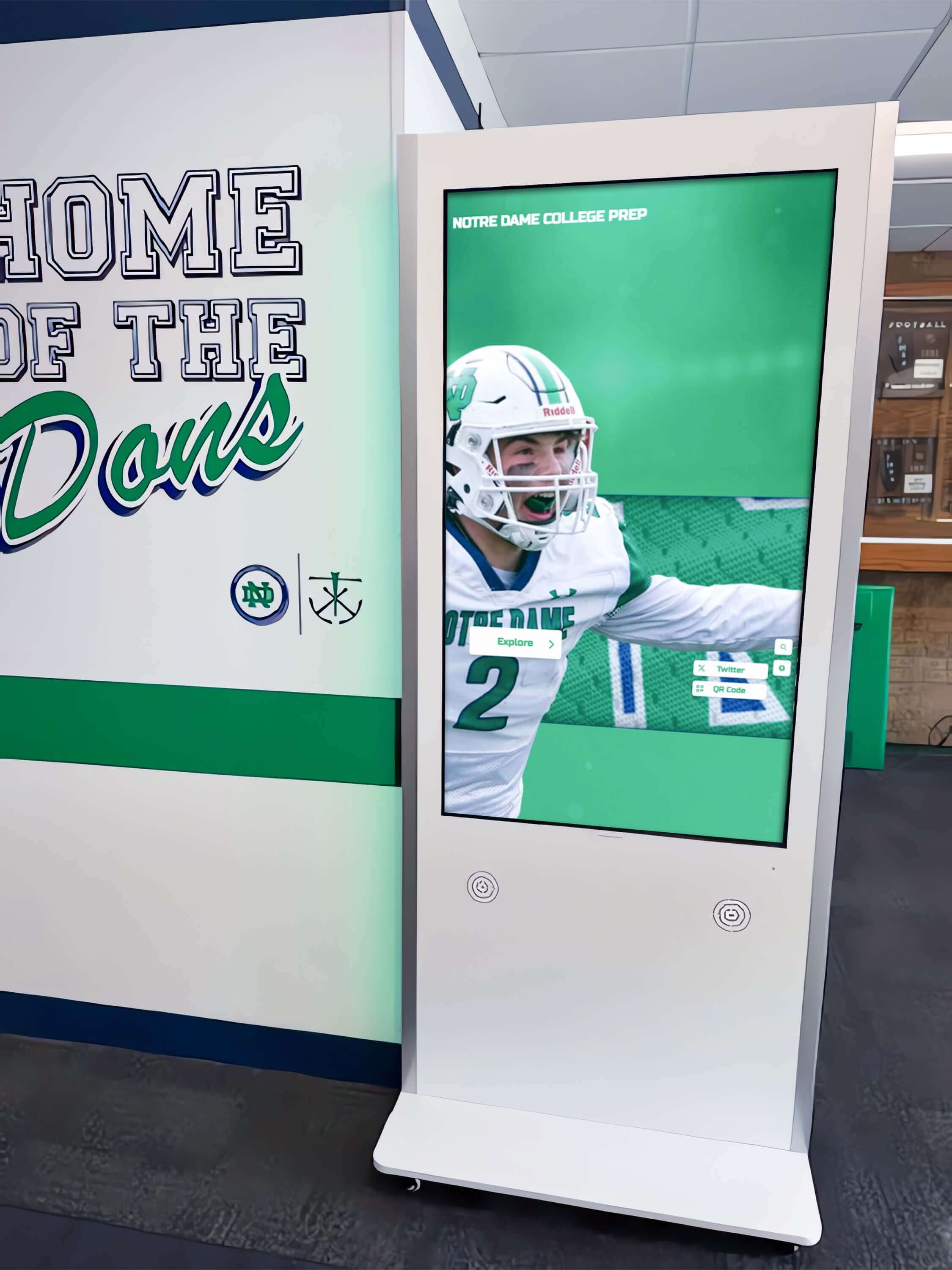
What is a Digital Hall of Fame? Complete Guide to Modern Recognition Technology
A digital hall of fame is an interactive recognition system that replaces traditional trophy cases and static plaques with dynamic, multimedia displays. These modern platforms combine touchscreen technology, searchable databases, and cloud-based content management to celebrate achievements across athletics, academics, arts, service, and alumni contributions. Unlike physical displays constrained by space and cost, digital halls of fame offer unlimited capacity, rich storytelling through photos and videos, and instant updates that keep recognition current and engaging. From small high schools to major universities, institutions are discovering that digital halls of fame deliver more inclusive, accessible, and impactful recognition while reducing long-term costs associated with fabricating and maintaining traditional displays. This comprehensive guide explains exactly what digital halls of fame are, how they work, what they cost, and why they represent the future of institutional recognition. Understanding Digital Halls of Fame: Definition and Core Concept A digital hall of fame is a technology platform that digitally recognizes and celebrates individual and team achievements through interactive displays and searchable online databases. At its most basic level, a digital hall of fame replaces physical plaques, trophy cases, and printed banners with digital screens displaying recognition content.
Read More
End of Semester Honor Roll Digital Display: The Complete Recognition Solution Guide
End-of-semester honor roll recognition marks a critical moment when schools celebrate academic achievement and motivate students toward continued excellence. Traditional bulletin boards and printed lists fail to create the lasting impact that modern students deserve. This comprehensive guide explores how digital display solutions transform semester-end honor roll recognition, comparing top platforms and providing decision frameworks to help schools choose the most effective solution for celebrating academic success. The final weeks of each semester bring significant milestones in the academic calendar—final exams complete, grades submitted, and honor roll lists compiled. For students who maintained strong academic performance throughout challenging months of coursework, this recognition moment matters tremendously. Yet many schools still rely on temporary recognition methods that diminish the significance of students’ achievements before the celebration even begins.
Read More
Honor Roll Digital Recognition: Complete Implementation Guide for Schools 2025
Honor roll recognition represents one of education’s most enduring traditions—celebrating students who demonstrate exceptional academic achievement and dedication to learning. As educational institutions modernize their recognition approaches, digital honor roll systems are transforming how schools acknowledge and motivate student excellence. This comprehensive guide explores how digital recognition platforms enhance traditional honor roll programs while delivering measurable benefits for student engagement, institutional pride, and operational efficiency.
Read More
Why Many Schools Regret Rushing Into Digital Hall of Fame Software
The promise is compelling: transform your outdated trophy cases and crowded plaque walls into sleek, interactive digital displays that celebrate unlimited achievements while engaging students, alumni, and visitors in entirely new ways. Sales demonstrations showcase stunning visuals, intuitive touchscreens, and impressive features that make digital hall of fame software seem like the obvious solution for modern school recognition programs. Yet increasingly, athletic directors, principals, and technology coordinators are discovering that hasty purchasing decisions based on polished presentations lead to expensive regrets, frustrated stakeholders, and recognition systems that fail to deliver promised value. Understanding why schools regret rushing into digital hall of fame software—and more importantly, what to evaluate before committing—can save your institution from costly mistakes while ensuring your recognition program receives the technology it truly deserves. The Growing Trend: Schools Embracing Digital Recognition Before examining where implementations go wrong, it’s important to acknowledge that digital hall of fame software, when properly selected and implemented, genuinely transforms school recognition programs. Modern platforms eliminate physical space constraints, enable rich multimedia storytelling, simplify content updates, and create engaging interactive experiences that static displays cannot match.
Read More
How to Train Staff on Digital Recognition Display Systems: Complete 2025 Guide
Schools and organizations investing in digital recognition displays often focus intensely on hardware selection, software features, and initial content creation—while inadvertently overlooking the most critical factor determining long-term success: comprehensive staff training. Without proper training, even the most sophisticated digital recognition systems underperform, sitting idle or displaying outdated content because staff members lack confidence, knowledge, or skills to manage these systems effectively. The consequences of inadequate training extend far beyond technical frustration. Organizations experience recognition program abandonment within months, wasted technology investments sitting unused in hallways, staff resistance to digital initiatives creating cultural barriers, missed recognition opportunities damaging morale, and dependence on single individuals creating vulnerability when personnel changes occur. These challenges stem not from technology limitations but from insufficient attention to the human element of digital transformation.
Read More
8 Best Digital Hall of Fame Software for Schools (2026 Guide)
In 2026, schools across the nation are transforming how they recognize student achievements, athletic excellence, and alumni contributions through digital hall of fame software. The days of static trophy cases and crowded plaque walls are giving way to dynamic, interactive displays that celebrate unlimited achievements while engaging students, families, and communities in entirely new ways. Whether you're an athletic director seeking to showcase decades of championship history, a principal looking to honor academic excellence, or an alumni coordinator wanting to connect graduates with current students, choosing the right digital hall of fame software can dramatically enhance your recognition program's impact. This comprehensive guide evaluates the eight best digital hall of fame software solutions for schools in 2026, comparing features, pricing, implementation approaches, and real-world suitability to help you make the best decision for your institution. Why Schools Are Embracing Digital Hall of Fame Software in 2026 Traditional recognition methods face limitations that become more apparent every year. Physical trophy cases run out of space, requiring difficult decisions about which achievements to display and which to store away. Static plaques provide minimal context about honored individuals, reducing complex achievements to names and dates. Updating physical displays requires fabrication, installation, and significant expense for every change.
Read More
Compare Digital Signage Options for My School: 2025 Buyer's Guide to Making the Right Choice
Choosing the right digital signage solution for your school involves navigating a complex landscape of hardware options, software platforms, use cases, and budgets. From recognition displays celebrating student achievement to communication systems sharing daily announcements, the stakes are high—digital signage investments typically last 7-10 years and significantly impact how schools communicate, celebrate, and connect with their communities. This comprehensive guide helps school administrators, technology coordinators, and decision-makers compare digital signage options methodically, ensuring selections align with specific needs, budgets, and long-term strategic goals. Understanding Your School’s Digital Signage Needs Before comparing specific solutions, clarifying your school’s primary objectives and use cases provides the foundation for informed decision-making.
Read More
Digital Signage for Schools: Complete 2025 Guide and Provider Rankings
Modern schools face unprecedented communication challenges. From emergency notifications requiring instant distribution to celebrating student achievements that build school culture, educational institutions need reliable, engaging ways to share information with students, staff, families, and visitors. Digital signage has emerged as the solution—transforming static bulletin boards and paper flyers into dynamic, attention-grabbing communication systems that keep school communities informed, engaged, and connected. This comprehensive guide explores everything schools need to know about digital signage in 2025, including detailed provider comparisons, implementation strategies, real-world applications, and best practices for maximizing your investment. What is Digital Signage for Schools? Digital signage refers to electronic displays—typically LCD or LED screens—that show multimedia content including text, images, videos, and real-time information. In educational settings, these systems replace or supplement traditional communication methods with dynamic digital displays positioned throughout school facilities.
Read More
Gipper vs Touchpros: Complete Comparison Guide for School Recognition Displays 2025
When schools and organizations evaluate touchscreen software for digital recognition displays, two names frequently surface: Gipper and Touchpros. Both platforms offer solutions for showcasing achievements, but they come from very different backgrounds and serve different primary purposes. This comprehensive comparison examines the strengths and limitations of each platform, while exploring why Rocket Alumni Solutions has emerged as the leading choice for schools seeking modern technology, intuitive interfaces, and outstanding client support. Whether you're implementing your first digital hall of fame or upgrading an existing system, understanding these platform differences is essential for making an informed decision that serves your institution for years to come. Understanding the Platforms: Origins and Core Expertise Before diving into feature comparisons, it’s important to understand where each platform originated and what they were fundamentally designed to accomplish.
Read More
Best Touchscreen Display for Schools: Complete Buyer's Guide to Interactive Technology for Education 2025
Schools face unprecedented choices when selecting touchscreen displays for educational environments. From interactive flat panels transforming classroom instruction to recognition displays celebrating student achievement in hallways, the right touchscreen technology enhances learning while building school culture. Yet with dozens of manufacturers, countless specifications, and budgets ranging from thousands to tens of thousands of dollars, making informed decisions proves challenging.
Read More
Rise Vision Alternatives: Free Digital Signage Solutions That Go Further
Schools and organizations searching for Rise Vision alternatives increasingly seek solutions that deliver more than simple slide rotations and basic announcements. While Rise Vision has served educational institutions for years, many administrators discover its limitations when trying to create engaging, interactive recognition programs or maintain comprehensive digital archives. This guide explores the best Rise Vision alternatives in 2025, with particular focus on Rocket Alumni Solutions—a completely free recognition platform that transforms how schools celebrate achievements, honor alumni, and preserve institutional history through interactive touchscreen displays and unlimited cloud-based content management. Understanding Rise Vision: What It Does and Where It Falls Short Rise Vision functions as a digital signage platform designed primarily for rotating content displays in schools, churches, and nonprofit organizations. The system allows administrators to create slideshows, announcements, and informational displays that cycle through content on screens throughout facilities.
Read More
Best Touchscreen for Schools: Complete Guide to Interactive Displays for Classrooms & Recognition
Modern schools are experiencing a digital transformation that extends far beyond traditional computer labs. Interactive touchscreen displays have become essential tools that enhance learning in classrooms while revolutionizing how schools recognize achievements throughout their facilities. From interactive flat panel displays that make lessons come alive to digital recognition walls celebrating student success, touchscreen technology is reshaping the educational experience.
Read More
Digital Class Composites: Modernizing School Recognition & Yearbook Traditions
Class composites have been a cherished tradition in schools and universities for over a century, preserving graduating classes in formal photographic displays. Today, digital class composites are revolutionizing this tradition by transforming static printed photographs into dynamic, interactive experiences that engage students, alumni, and visitors in entirely new ways. These modern recognition systems combine the timeless value of class composites with the power of touchscreen technology, creating searchable databases that honor every student while solving the space limitations and update challenges of traditional approaches. Whether you’re exploring modern alternatives to printed composites, seeking ways to digitize historical class photos, or looking to create more engaging student recognition, this comprehensive guide reveals how digital class composites deliver superior value for educational institutions of all sizes.
Read More
Interactive Boards for Student Achievement Recognition: Complete Guide to Engaging Digital Displays
Imagine walking through your school's main hallway and seeing students gathered around a vibrant digital display, excitedly searching for their names, watching videos of alumni success stories, and discovering achievements of peers they never knew existed. This is the power of interactive boards for student achievement recognition—technology that transforms static wall space into dynamic engagement hubs that celebrate success, inspire excellence, and build school pride. This comprehensive guide explores how interactive boards revolutionize student recognition, what features drive engagement, and how schools can implement systems that meaningfully honor achievements while motivating future success. Understanding Interactive Boards for Student Achievement Interactive boards represent a fundamental evolution in how schools recognize and celebrate student accomplishments, moving from one-way displays to two-way engagement platforms.
Read More
The Benefits of Digital Asset Management for School Districts: Complete Implementation Guide
School districts generate tens of thousands of digital files annually—photos from sporting events, videos of performances, historical yearbooks, student artwork, marketing materials, and countless other media assets. Without proper organization, these valuable resources become scattered across personal devices, network drives, and disconnected systems, making them nearly impossible to find when needed. Digital asset management (DAM) provides school districts with centralized systems to organize, preserve, and leverage these materials effectively, transforming chaos into strategic institutional resources that serve schools, staff, students, and communities for generations. Why School Districts Need Digital Asset Management The explosion of digital content in education shows no signs of slowing. Districts that managed hundreds of photos annually a decade ago now handle tens of thousands. Video content, once rare due to file size limitations, is now commonplace for everything from sporting events to classroom instruction and board meetings. This growth creates serious operational challenges across multiple schools and departments.
Read More
The Best Software Solutions for Education Records Digitization in 2025
Educational institutions manage vast quantities of important records—student transcripts, yearbooks, achievement documentation, historical archives, and administrative files accumulated over decades or even centuries. These physical records occupy valuable space, deteriorate over time, and prove difficult to search and access when needed. Education records digitization transforms these paper-based systems into searchable digital archives that preserve institutional history while dramatically improving accessibility and efficiency. This comprehensive guide explores the best software solutions available in 2025 for digitizing educational records, helping schools and universities select the right tools for their specific needs. Understanding Education Records Digitization Education records digitization involves more than simply scanning documents. Comprehensive digitization creates organized, searchable digital archives with proper metadata, security controls, and long-term preservation standards that protect institutional memory while enabling efficient daily operations.
Read More
Digital Asset Management for Schools: Complete Guide to Organizing and Preserving Educational Media
Schools generate thousands of digital files annually—photos from events, videos of performances, historical yearbooks, student artwork, and countless other media assets. Without proper organization, these valuable resources become scattered across personal devices, shared drives, and outdated systems, making them nearly impossible to find when needed. Digital asset management (DAM) provides schools with centralized systems to organize, preserve, and leverage these materials effectively, transforming chaos into strategic institutional resources that serve students, staff, and communities for generations. Understanding Digital Asset Management in Educational Settings Digital asset management represents far more than simple file storage. While cloud drives like Google Drive or Dropbox offer basic storage capabilities, true DAM systems provide comprehensive solutions specifically designed for managing large volumes of diverse media types with complex organizational needs.
Read More
Why Rocket Interactive Recognition Displays Beat Traditional Digital Signage: Complete Comparison Guide
When organizations evaluate display technology for recognition programs, they often encounter a fundamental choice: traditional digital signage or purpose-built interactive recognition displays. While both use similar hardware, the difference in functionality, engagement, and outcomes is substantial. This comprehensive guide examines why interactive recognition solutions like Rocket Alumni Solutions deliver dramatically superior results compared to traditional digital signage for schools, universities, and recognition-focused organizations. Understanding the Fundamental Difference Before diving into detailed comparisons, it’s essential to understand that digital signage and interactive recognition displays serve fundamentally different purposes, despite appearing similar on the surface.
Read More
Complete Hardware Selection Guide for Digital Recognition Displays: Everything Schools Need to Know
Selecting the right hardware for digital recognition displays represents one of the most critical decisions schools make when implementing interactive touchscreen systems. Unlike choosing software, which can be updated or replaced, hardware selections directly impact display quality, reliability, maintenance costs, and system lifespan for 5-10 years. This comprehensive guide provides the technical knowledge schools need to make informed hardware decisions that deliver lasting value. When schools invest in digital recognition technology, hardware quality determines whether installations become valued institutional assets or problematic maintenance burdens. Commercial-grade components engineered for continuous operation deliver dramatically better performance than consumer alternatives, while proper specifications ensure displays meet visibility, interactivity, and durability requirements for demanding educational environments.
Read More
National Honor Society Digital Recognition Display: Modern Solutions for Celebrating Academic Excellence
The National Honor Society (NHS) represents the pinnacle of student achievement, recognizing excellence in scholarship, leadership, service, and character. As schools modernize their recognition programs, digital displays are transforming how institutions celebrate NHS members and their accomplishments. This comprehensive guide explores how digital recognition systems elevate National Honor Society programs while creating lasting impressions for students, families, and school communities. The National Honor Society has been a cornerstone of academic recognition in American schools for over a century. Since its founding in 1921, NHS has recognized millions of students who demonstrate exceptional achievement across four essential pillars: scholarship, leadership, service, and character. Today’s schools are discovering that digital recognition displays offer powerful new ways to honor these outstanding students while creating dynamic, engaging presentations that resonate with modern audiences.
Read More






























